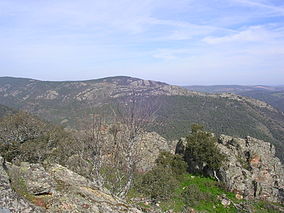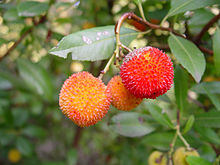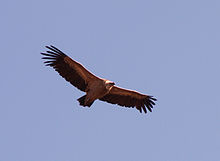- Despeñaperros
-
Despeñaperros Natural Park 
Location Andalusia, Spain Coordinates 38°23′10″N 3°30′25″W / 38.38611°N 3.50694°WCoordinates: 38°23′10″N 3°30′25″W / 38.38611°N 3.50694°W Area 76.49 square kilometres (29.53 sq mi) Established 1989 Governing body Ministry of the Environment Despeñaperros (lit. dogs plunging [over the cliff]) is a gorge or canyon carved out by the Despeñaperros River. It is located in the municipality of Santa Elena in the northern portion of the province of Jaén, Spain. The 76.49-square-kilometre (29.53 sq mi) area was declared a natural park by the Andalusian Autonomous Government, primarily for its geology and landscape, but also for its notable flora and fauna.
The gorge has steep walls, some more than 500 metres (1,600 ft) in height. It has historically been much used by humans as a natural pass through the Sierra Morena, constituting a principal path of connection between Andalusia and the Meseta Central, Castile-La Mancha, and the rest of Spain. Today the Despeñaperros is the route of the Autovía A-4 and of one of Andalusia's most important railway connections to the rest of Spain. Until the 1992 construction of the high-speed Puertollano–Córdoba route (90 kilometres (56 mi) to the west), this rail route was second in importance only to the Mérida–Seville line in terms of connecting from Andalusia to the rest of Spain.
Contents
Geology
Despeñaperros is located at the eastern limit of the Sierra Morena. The mountain range is oriented east-west, but is crossed by some rivers oriented north-south, so that some zones of the Meseta Central drain south to the Guadalquivir and thence to the Atlantic Ocean, crossing the theoretical natural barrier of the range. One of these is the Despeñaperros River, but the Guarrizas also crosses 11 kilometres (6.8 mi) to the east, forming the beautiful Cimbarra Falls, protected as a paraje natural. The Despeñaperros flows into the Guarrizas about 10 kilometres (6.2 mi) south of the gorge.
The vertical walls of the gorge expose geological layers that reveal the history of the surrounding land. The walls are composte of extremely hard vertical walls composed of "Armorican" quartzite, formed in the ocean 500 million years ago in the Paleozoic, which were later covered by more recent materials. In the Carboniferous these were elevated and exposed to erosion, finally to be discovered here and at Cimbarra Falls. According to the prevailing theory, it took some 320 million years of the Variscan orogeny for the continental collison of Laurasia and Gondwana to crush the Armorican continent.
In the strata of "Armorican" quartzite some spectacular ripples or crinkles are visible, fossil effects of waves, similar to those that can be observed in any deep, sandy sea, which reveals their origin. Also, fossil traces remain of organisms that left their mark in the sandy sediments some 500 years ago.
Among the formations visible in Despeñaperros are several that have been given names of their own: El Salto del Fraile ("Friar's Leap"), Las Correderas ("The Slides"), or Los Órganos ("The Organs"). In this last, the quartzite had been folded until it stood in vertical strata, which erosion then gave the forms of pointed tubes, evoking the musical instrument, the organ. Los Órganos has status as a natural monument in its own right.
Flora
Like the rest of the eastern Sierra Morena, The dominant vegetation of Despeñaperros is Mediterranean forest. Holm Oak (Quercus ilex) and Cork Oak (Quercus suber) predominate, along with Portuguese Oak (Quercus faginea), Pyrenean Oak (Quercus pyrenaica) and various pines: Stone pine (Pinus pinea), Aleppo Pine (Pinus halepensis), and European Black Pine (Pinus nigra. The predominant shrubs are Strawberry Trees (Arbutus unedo), Heather (genus Erica), rockroses of the genus Cistus, Myrtle (genus Myrtus) and Kermes Oak (Quercus coccifera).
There are also riparian forests along the various rivers and streams, shadier and more humid, with alders (genus Alnus), Ash (genus Fraxinus) and Willows (genus Salix).
The natural park also holds 30 endemisms—endemic species or subspecies— unique in the world, and others unique in the Iberian Peninsula.
Fauna
There is an important presence of deer (Cervidae) and wild boars (Sus scrofa); there are authorized hunts of both. There are also Iberian Lynxes (Lynx pardinus) and wolves, as well as small carnivores such as foxes, el Egyptian Mongooses (Herpestes ichneumon) and wildcats (Felis silvestris).
Birds in Despeñaperros include the Spanish Imperial Eagle (Aquila adalberti, also known as Adalbert's Eagle) and the Griffon Vulture (Gyps fulvus).
History
Despeñaperros, as well as Cimbarra Falls and the caves in the area, has important examples of Neolithic cave painting, proof that humans have long been aware of these passages between the Meseta Central and Andalusia. Notable among the area's caves are the Cueva de los Muñecos and the Cuevas de las Vacas del Rematoso.
External links
- (Spanish) Parque Natural de Despeñaperros, official site of Santa Elena municiplaity, within whose borders the park falls; warning: heavy use of Adobe Flash
- (Spanish) Parque Natural Despeñaperros, Ventana del Visitante de los Espacios Naturales Protegidos de Andalucía (Despeñaperros Natural Park on the official site of the Autonomous Andalusian Government)
- (Spanish) Los Órganos, Ventana del Visitante de los Espacios Naturales Protegidos de Andalucía ("Los Órganos" on the official site of the Autonomous Andalusian Government)
- This article incorporates information from the revision as of 2009-12-22 of the equivalent article on the Spanish Wikipedia.
Categories:- Jaén Province (Spain)
- Geography of Andalusia
- Natural parks of Spain
- Canyons and gorges of Spain
Wikimedia Foundation. 2010.


